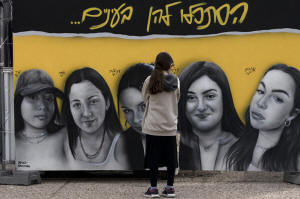Qatar says ceasefire between Israel and Hamas will go into effect at
8:30 a.m. on Sunday
 Send a link to a friend
Send a link to a friend
 [January 18, 2025]
By SAMY MAGDY and SAM MEDNICK [January 18, 2025]
By SAMY MAGDY and SAM MEDNICK
CAIRO (AP) — The ceasefire between Hamas and Israel will go into effect
in less than 24 hours, said Qatar’s foreign ministry on Saturday.
In a post on X, Qatar’s foreign minister Majid al-Ansari, said the
ceasefire will start at 8:30 a.m. (0630 GMT) Sunday. He advised people
to exercise caution when the agreement goes into effect and wait for
directions from officials.
Early Saturday morning, Israel’s Cabinet approved the deal for a
ceasefire in Gaza that would release dozens of hostages and pause the
15-month war with Hamas, bringing the sides a step closer to ending
their deadliest and most destructive fighting ever.
Despite the ceasefire news, sirens sounded across central Israel on
Saturday, with the army saying it intercepted projectiles launched from
Yemen. The Iran-backed Houthis have stepped up their missile attacks, in
recent weeks. The group says the attacks are part of their campaign
aimed at pressuring Israel and the West over the war in Gaza.
There were also continued Israeli strikes into Gaza. The Palestinian
Health Ministry said at least 23 people were killed in the previous day.

Under the first phase of the ceasefire, 33 hostages are set to be
released over the next six weeks, in exchange for hundreds of
Palestinians imprisoned by Israel. The remainder, including male
soldiers, are to be released in a second phase that will be negotiated
during the first. Hamas has said it will not release the remaining
captives without a lasting ceasefire and a full Israeli withdrawal.
According to the ceasefire plan, approved by the Cabinet and signed by
Israel’s national security adviser, the exchange will begin Sunday at 4
p.m. (1400 GMT). During each exchange, prisoners will be released by
Israel after the hostages have arrived safely.
The plan says that during phase one, some 1,900 Palestinian prisoners
will be released, in exchange for 33 Israeli hostages, both alive and
dead. Among the prisoners, 1,167 are residents in Gaza who were held by
Israel but were not involved in Oct. 7. All women and children under 19
from Gaza held by Israel will be freed during this phase.
All Palestinian prisoners who were convicted of deadly attacks will be
exiled, either to Gaza or abroad, and barred from returning to Israel or
the West Bank. Some will be exiled for three years and others
permanently, according to the plan.
Key questions remain about the ceasefire, however — the second achieved
during the war — including the names of the 33 hostages who are to be
released and who among them is still alive.
[to top of second column]
|

A girl pauses at a mural of female Israeli soldiers held by Hamas in
the Gaza Strip, in Tel Aviv, Israel, as Israel's security cabinet
convened to decide whether to approve a deal that would release
dozens of hostages held by militants in Gaza and pause the
15-month-war, Friday, Jan. 17, 2025. Hebrew reads: "look them in the
eyes." (AP Photo/Maya Alleruzzo)

Hamas has agreed to free three female hostages on Day 1 of the deal,
four on Day 7 and the remaining 26 over the following five weeks.
Palestinian detainees are to be released as well. Israel’s justice
ministry published a list of more than 700 who are to be freed in
the deal’s first phase and said the release will not begin before 4
p.m. local time Sunday. All people on the list are younger or
female.
Also during the first phase, Israeli troops are to pull back into a
buffer zone about a kilometer (0.6 miles) wide inside Gaza, along
its borders with Israel.
That will allow displaced Palestinians to return to their homes,
including in Gaza City and northern Gaza. With most of Gaza’s
population driven into massive, squalid tent camps, Palestinians are
desperate to get back to their homes, even though many were
destroyed or heavily damaged by Israel’s campaign.
The largely devastated territory should also see a surge in
humanitarian aid. Trucks carrying aid lined up Friday on the
Egyptian side of the Rafah border crossing into Gaza. On Saturday,
two Egyptian government ministers arrived in the northern Sinai
Peninsula to oversee the preparations for the delivery of aid and to
receive the evacuation of wounded patients, the health ministry
said.
Hamas triggered the war with its Oct. 7, 2023, cross-border attack
into Israel that killed some 1,200 people and left some 250 others
captive. Nearly 100 hostages remain in Gaza.
Israel responded with a devastating offensive that has killed more
than 46,000 Palestinians, according to local health officials, who
do not distinguish between civilians and militants but say women and
children make up more than half the dead.
——
Mednick reported from Jerusalem. Associated Press reporter Joe
Federman in Jerusalem contributed.
All contents © copyright 2025 Associated Press. All rights reserved
 |